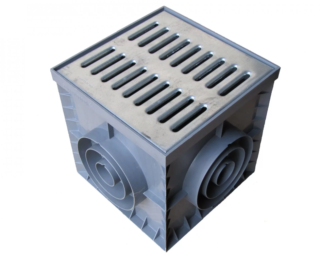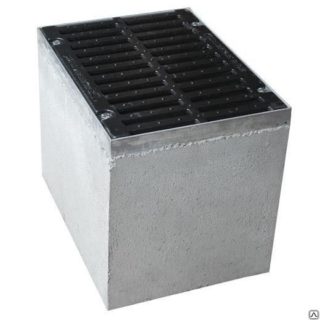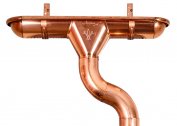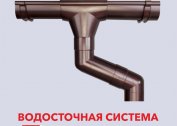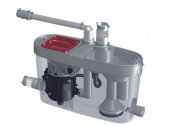The device of a point (closed) storm shower requires the presence of a special reservoir in its design - a storm water inlet. It is intended for the initial accumulation of rain / melt water and its further transportation to the discharge point through pipes deepened into the ground. Proper installation of a storm water inlet with your own hands ensures the operation of the drainage system without failures and breakdowns.
Types and arrangement of storm water inlets for storm sewers
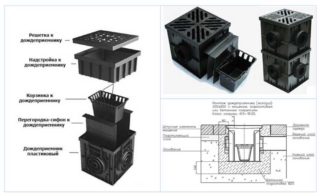 Structurally, the tank is a chamber equipped with a siphon partition, a removable basket and an upper protective grille. In some models of reservoirs, additional elements are provided in the form of a reinforcing edging, gaskets, a cover and an extension to the stormwater element. In addition, in the storm water inlet device for storm sewage there are two options for water drainage:
Structurally, the tank is a chamber equipped with a siphon partition, a removable basket and an upper protective grille. In some models of reservoirs, additional elements are provided in the form of a reinforcing edging, gaskets, a cover and an extension to the stormwater element. In addition, in the storm water inlet device for storm sewage there are two options for water drainage:
- Removing fluid down. Such stormwater elements direct water into the soil, immediately into the drainage well.
- Removal of effluents to the side. Such a tank is connected to the pipes in a single design.
All storm water inlets differ in size, permissible loads, type of material and shape. Tanks for storm drains are marked depending on their purpose:
- D. Marking means "storm water inlet". The element is used in private areas and in the pedestrian zone.
- DB1 and DB2. It is interpreted as "a large storm water inlet". It is mounted in parking lots and along the carriageways of urban parts.
- DM1 and DM2. Storm water inlet trunk.
- DS1 and DS2. Extra heavy storm water inlet. Designed for installation in areas with maximum load.
- DK. The storm water inlet is round.
The material for the production of an element for the point collection of rainwater: cast iron, plastic and concrete.
Cast iron storm water inlets
Cast iron shower elements are the most durable and heavy. SCh20 metal perfectly withstands loads from 15 to 25 tons (depending on the size of the tank), is inert to aggressive environments, durable and corrosion resistant. More often pig-iron storm water inlets are used at the device of city sewer highways. The tanks have high throughput and at the same time good environmental friendliness. Metal poses no threat to the environment.
Installation of the storm water inlet to the blind area of the house, provided that the cast-iron construction, must be accompanied by a special concrete base. Otherwise, the metal will begin to rust. In addition, working with cast iron elements is difficult because of their heavy weight.
Plastic
Polymer tanks are widely used in private and municipal construction. Plastic has the following advantages:
- light weight;
- high resistance to temperature changes;
- inertness to chemical / aggressive environments;
- ease of installation and maintenance;
- a wide selection of models in size and shape;
- favorable cost of products.
It’s easy to take care of polymer tanks under rainwater: dirt, silt, sand are easily washed with a stream of water.
All plastic models are marked depending on their rated load:
- A. The load is up to 1,500 kg. This option is good for private construction.
- B. The storm water inlet copes with a load of up to 12.5 t.
- C. Maximum load capacity up to 25 tons.
- D. Load up to 40 t.
- E. Nominally withstands up to 60 tons.
- F. Able to withstand loads up to 90 tons.
It is better to buy a storm water inlet, which is able to withstand a slightly larger load than was obtained in the calculations.
Concrete
Such a storm water inlet has a slightly lower weight than a cast iron one.The material is resistant to aggressive wastewater, durability and good throughput. But the inner surface of concrete tanks is slightly rough, which provokes the growth of silt on its walls over time. Accumulated sludge will produce an unpleasant odor during the evaporation of moisture from the tank. In addition, concrete is a massive material that requires the use of special equipment when laying.
Massive rough concrete can be replaced with lighter and smoother polymer concrete. The polymers added as reinforcing fibers make the final product light, strong, and prone to undergo high loads.
Criterias of choice
The following factors influence the choice of type and model of a storm water inlet:
- The total area of the territory from which rainwater will be removed. Through it, the volume of runoff in the seasons of rains and snowfalls is determined.
- Water absorption coefficient of the available coating. For asphalt, it is 0.89, for the roof - 1, for crushed stone - 0.4.
- Weight and type of material. It should be borne in mind that cast iron elements are prohibited for use in solonchak soils, otherwise the salt will spoil the metal over time. More often in private construction use plastic storm water inlets.
- The level of the rated load on the tank.
- Cost and dimensions.
- The presence of additional elements: locking mechanism, gaskets, etc.
If the price does not suit any of the tank options and at the same time there is an extra brick on the site, you can lay out the well of the storm water inlet from it. It is important to correctly calculate the desired volume and then plaster / paint the tank from the inside.
Mounting Features
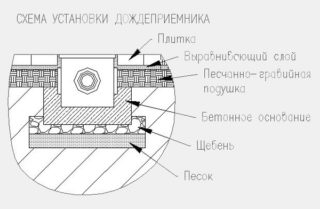 The correct installation of the storm water inlet is guaranteed with strict observance of the installation technique. They work in the following sequence:
The correct installation of the storm water inlet is guaranteed with strict observance of the installation technique. They work in the following sequence:
- Preparation of the pit. Its depth should be equal to the height of the tank with a grill plus 30 cm on a bed of sand and concrete. On the walls, the dimensions of the pit are increased by 15-20 cm on each side for concrete pouring.
- A layer of sand 15 cm thick is poured at the bottom of the pit and well tamped with it.
- Concrete mortar from cement and crushed stone is poured from above. The mass is allowed to dry under the installation of the tank. Such a platform will serve as a reliable foundation. During the pouring of concrete, evenness is monitored using a building level.
- On the cured solution, the storm water inlet is installed at the level, having previously released the pipe from the gasket. A rainwater branch is inserted into the reservoir and all joints are coated with sealant.
- The storm water inlet is poured from all sides with concrete mortar to the very top edge. During pouring, it is necessary to carefully expel air from the solution with a metal rod, otherwise the walls of the reinforcement will be porous and brittle. Subsequently, they may succumb to heaving soil.
- Once the mortar is well set, you can install the basket and the upper protective grille.
When installing the storm water inlet to the blind area, it is better to do all the work even at the stage of its filling, so as not to break the already frozen area around the house in the future.
When installing a reservoir for collecting rainwater, it is worth considering the ability of the soil to narrow, expand and heave at temperature extremes. Therefore, saving on concrete pouring the storm water inlet is not worth it. Otherwise, over time, it may float like a float. The soil will just push it out.

